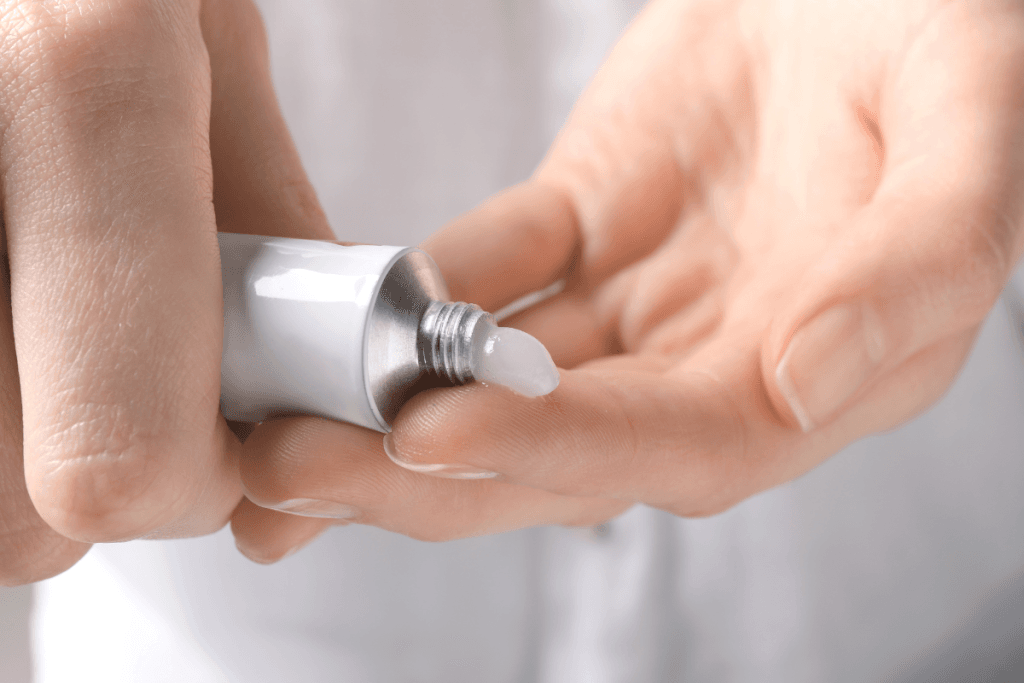EMLA cream (Eutectic Mixture of Local Anesthetics) is widely used in clinical settings to provide effective numbing for minor medical procedures, reducing patient discomfort and pain. As a topical anesthetic, it is frequently applied before needle insertions, minor skin surgeries, and cosmetic procedures. Medical practitioners have long trusted EMLA cream for its efficacy and safety, making it an essential tool in patient care. This guide will explore how EMLA numbing cream works, its proper application, and other considerations such as prescription, pricing, and its availability over the counter.
What Is EMLA Cream?
EMLA cream is a topical anesthetic composed of two active ingredients, lidocaine, and prilocaine, which belong to the amide class of local anesthetics. These components work synergistically to block nerve signals in the skin, providing temporary numbness to the applied area. The cream is commonly used to numb the skin for minor procedures like venipuncture, vaccinations, superficial surgeries, and laser treatments.
The versatility of EMLA cream makes it a staple in various medical and cosmetic practices. Its rapid onset of action and ability to provide localized numbing without systemic effects have made it one of the most popular anesthetic creams.
EMLA Cream Uses in Clinical Practice
EMLA cream uses a wide range of minor procedures where pain management is essential. Its primary application is to reduce pain during:
- Blood draws, IV insertions, and injections
- Minor skin surgeries or biopsies
- Laser treatments, including hair removal
- Dermatological procedures like mole removal
- Vaccinations and immunizations
In pediatric care, EMLA cream is beneficial for minimizing pain during needle-related procedures. Its effective numbing capabilities help reduce anxiety in both children and adults, making it easier for clinicians to perform necessary interventions.
EMLA Cream: How to Use It Properly
Using EMLA cream correctly maximizes its numbing effect while ensuring patient safety. Typically, a thick layer of EMLA cream is applied to the skin and covered with an occlusive dressing, such as the EMLA patch, to ensure the cream stays in place and penetrates the skin. The cream must be applied 30 to 60 minutes before the procedure, depending on the depth of anesthesia required.
The cream is wiped off once the recommended time has passed, and the procedure can proceed with minimal discomfort. It’s important to note that numbness depends on the area treated, but the numbing effect generally lasts about one to two hours after removal. Practitioners should be mindful of the specific procedure and adjust the application time accordingly.
How Long Does EMLA Cream Last?
Generally, the numbing effect of EMLA cream can last anywhere between one to two hours, although individual responses may vary. After removing the cream, the anesthetic effect gradually wears off, providing enough time for most minor procedures to be completed comfortably.
For more prolonged procedures, it’s essential to correctly time the cream’s application to ensure sustained pain relief. In cases requiring extended numbing, additional anesthetic measures may be necessary.
EMLA Cream Prescription and Availability
While EMLA cream is available over the counter in some regions, it may require a prescription depending on the country and the intended use. EMLA cream over the counter is typically used for less invasive procedures, whereas more complex uses may necessitate a doctor’s guidance. In regions where an EMLA cream prescription is required, it’s often obtained for medical uses such as minor surgeries or more invasive procedures.
For medical professionals, understanding the regulations surrounding the purchase and application of EMLA cream is crucial in ensuring that patients receive proper care without unnecessary barriers to access.
EMLA Cream Pricing and Generic Availability
The EMLA cream price can vary depending on the location and whether it’s purchased over the counter or via prescription. As with many pharmaceuticals, generic versions of EMLA may be available at a lower cost, providing a more affordable option without sacrificing efficacy.
The EMLA cream generic contains the same active ingredients—lidocaine and prilocaine—and functions similarly to the branded version. Practitioners should consider cost-effectiveness when recommending products to patients, especially in procedures where multiple applications of the cream are required over time.
Take away
EMLA cream is an invaluable tool in pain management for minor procedures, offering patients effective and temporary relief from discomfort. Medical practitioners can optimize its use in clinical practice by understanding EMLA cream uses, proper application techniques, and the availability of generic versions. Whether used for injections, dermatological procedures, or minor surgeries, EMLA numbing cream provides a reliable, non-invasive method of anesthesia.
Staying informed about where to buy EMLA cream, its price, and its prescription requirements ensures that healthcare providers can offer the best patient care. As numbing agents are pivotal in improving patient experiences, EMLA cream remains a cornerstone in managing procedural pain.
Frequently Asked Questions (FAQs)
What are the main ingredients in EMLA cream?
EMLA cream ingredients include lidocaine and prilocaine, which are both local anesthetics. These two active ingredients block nerve signals, providing practical and temporary skin numbing.
Can I buy EMLA cream over the counter?
In some regions, EMLA cream over the counter is available for less invasive uses like numbing the skin for vaccinations or minor cosmetic procedures. However, more complex uses may require a prescription from a healthcare provider.
Where can I buy EMLA cream?
You can purchase EMLA cream from pharmacies, both physical and online. It’s important to check local regulations, as it may be available without a prescription in some countries, while in others, it may require a doctor’s prescription.
How long does EMLA cream take to work?
EMLA cream typically takes 30 to 60 minutes to numb the skin. Covering the applied area with an EMLA patch helps to increase absorption and ensure optimal effectiveness. It is essential to use the cream well before the procedure to ensure proper numbing.
Are there side effects to using EMLA cream?
While EMLA cream is generally safe, some patients may experience mild side effects such as redness, swelling, or itching at the application site. More severe side effects are rare but can include allergic reactions or skin irritation. Continually monitor patients for any adverse reactions following application.







